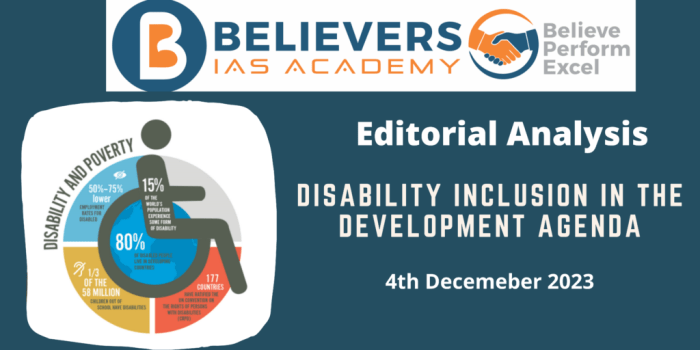
Kicking off with Disability rights and inclusion policies, this topic dives into the vital movements that shape the lives of individuals with disabilities. Understanding the historical context and legal frameworks, particularly the landmark Americans with Disabilities Act (ADA), provides a foundation for recognizing the ongoing struggles and advancements in disability rights globally.
This discussion not only highlights the significance of inclusion policies across various sectors, such as education and employment, but also examines how they impact the daily lives of those with disabilities. By exploring examples of effective strategies and the role of advocacy organizations, we can appreciate the strides made towards equality and accessibility.
Understanding Disability Rights
The journey toward disability rights has evolved significantly over the decades, leading to the recognition of the importance of inclusion and equality for individuals with disabilities. The historical context of disability rights movements reveals a struggle marked by advocacy, resilience, and a commitment to change, shaping the policies we see today. The Americans with Disabilities Act (ADA), enacted in 1990, represents a landmark moment in this movement, establishing a comprehensive framework for the rights of individuals with disabilities.
This legislation has had profound implications for inclusion policies across various sectors, from employment to public accommodations. By prohibiting discrimination and ensuring equal access, the ADA has become a critical tool for advocating for the rights of people with disabilities.
Historical Context of Disability Rights Movements
The disability rights movement has its roots in the civil rights movements of the 1960s and 1970s, driven by a growing awareness of the injustices faced by individuals with disabilities. Activists began organizing to combat institutionalization, advocate for better accessibility, and demand equal rights. Key historical milestones include the protests at the United Nations in 1977 and the Section 504 Sit-in, which played a crucial role in raising public awareness and influencing policy changes.
Significance of the Americans with Disabilities Act (ADA)
The ADA has had a monumental impact on how society views and includes individuals with disabilities. Its significance lies in several core areas:
- Anti-Discrimination: The ADA prohibits discrimination against individuals with disabilities in employment, public accommodations, transportation, and telecommunications.
- Accessibility Standards: The law sets forth requirements for accessible design in buildings and facilities, promoting an inclusive environment.
- Public Awareness: The ADA has contributed to the broader societal understanding of disability rights, helping to shift perceptions and reduce stigma.
Key Organizations Advocating for Disability Rights Globally
Numerous organizations play a vital role in advocating for disability rights on a global scale. These organizations work tirelessly to promote awareness, provide resources, and influence policy changes.
- International Disability Alliance (IDA): A network of global organizations representing persons with disabilities, advocating for their rights in international forums.
- American Association of People with Disabilities (AAPD): A leading national cross-disability organization that empowers people with disabilities and promotes their rights and inclusion.
- National Council on Independent Living (NCIL): Advocates for the rights of individuals with disabilities to live independently, emphasizing the importance of self-determination.
The disability rights movement has transformed the landscape of inclusion policies, advocating for equal opportunities and access for individuals with disabilities across all aspects of life.
Inclusion Policies in Various Sectors
Inclusion policies play a crucial role in ensuring that individuals with disabilities have equal access and opportunities across various sectors. By implementing these policies, organizations can foster an environment that not only values diversity but also recognizes the unique contributions of every individual. This section explores the significance of inclusion policies in education, workplace accommodations, and offers a comparative view of their effectiveness in different regions.
Inclusion Policies in Education
Inclusion policies in educational settings focus on integrating students with disabilities into mainstream classrooms, promoting a sense of belonging and equal opportunity for learning. These policies often lead to improved academic outcomes and social interactions, benefiting both students with disabilities and their peers. Key aspects of effective inclusion policies in education include:
- Individualized Education Programs (IEPs): These tailored programs are developed to meet the specific needs of students with disabilities, ensuring they receive the support necessary for their academic success.
- Co-teaching Models: In some schools, general education teachers and special education teachers work together to provide a supportive learning environment that addresses diverse learning needs.
- Accessibility Measures: Schools are implementing physical modifications, such as ramps and adaptive technology, to ensure all students can access facilities and resources.
The impact of these policies is profound, as they not only enhance educational attainment but also promote social skills and emotional well-being among students with disabilities.
Workplace Accommodation Strategies
Workplace inclusion policies mandate various accommodation strategies to support employees with disabilities, facilitating their full participation in the workforce. Employers are required to make reasonable adjustments to the work environment to meet the needs of these individuals. Examples of workplace accommodation strategies include:
- Flexible Work Hours: Allowing employees to adjust their work schedules can significantly contribute to their productivity and overall job satisfaction.
- Assistive Technologies: Providing tools such as screen readers, speech recognition software, and ergonomic equipment can help employees perform their tasks effectively.
- Remote Work Opportunities: Enabling employees to work from home can remove barriers such as commuting challenges and create a more comfortable working environment.
These strategies not only benefit employees with disabilities but also contribute to a more inclusive workplace culture that values diversity.
Comparison of Inclusion Policies Across Regions
The effectiveness of inclusion policies varies significantly across different countries and regions, influenced by cultural attitudes, legislative frameworks, and available resources. Notable differences can be observed in how these policies are implemented and the outcomes they yield.In regions such as Scandinavia, there is a strong emphasis on comprehensive inclusion strategies supported by robust government policies. For instance, countries like Sweden and Norway offer extensive support systems and funding for disability services, leading to high levels of accessibility and inclusion in both education and employment.Conversely, in some developing regions, the lack of awareness and resources can hinder the implementation of effective inclusion policies.
In these areas, individuals with disabilities may face significant barriers to education and employment, highlighting the need for targeted interventions and support.
The success of inclusion policies is often tied to the commitment of governments, organizations, and communities to create equitable opportunities for all individuals.
Related Insurance Considerations

The intersection of disability rights and insurance coverage is crucial for ensuring individuals with disabilities receive the support they need. Various types of insurance, including dental and health insurance, play a significant role in addressing the unique needs of this community. Additionally, challenges with specific insurance products, such as flood insurance, can have serious implications for individuals with disabilities.
Dental Insurance Coverage for Individuals with Disabilities
Dental health is a vital aspect of overall well-being, but individuals with disabilities often face unique challenges in accessing dental care. Dental insurance coverage can significantly alleviate financial burdens associated with necessary treatments. For individuals with disabilities, comprehensive dental insurance can cover a range of services including preventative care, orthodontics, and restorative procedures which may be essential for maintaining health.
“Having access to dental insurance enables individuals with disabilities to receive preventative care, which can prevent more serious health issues down the line.”
Health Insurance Policies Addressing Disability-Related Needs
Health insurance policies are designed to cater to a variety of health needs, including those specific to individuals with disabilities. These policies often include coverage for necessary medical equipment, therapies, and medications that are crucial for maintaining health and independence. Insurance companies may provide coverage for services such as physical therapy, occupational therapy, and speech therapy which are often necessary for rehabilitation and daily functioning.
For example, a study has shown that individuals with disabilities who have access to comprehensive health insurance are more likely to receive timely medical attention, thus reducing the risk of complications.
Challenges Faced with Flood Insurance
Flood insurance presents a unique set of challenges for individuals with disabilities. Accessibility and affordability are primary concerns when it comes to obtaining flood insurance. Many insurance policies exclude specific coverage for disability-related modifications made to a home, such as ramps or accessible bathrooms, which can lead to significant financial losses in the event of flooding.Furthermore, individuals with disabilities may reside in areas more susceptible to flooding due to socioeconomic factors, making the need for affordable flood insurance even more pressing.
The lack of understanding from insurance providers regarding the specific needs of individuals with disabilities can further complicate the claims process after a disaster, leaving many without the necessary support during critical times.
“The intersection of flood insurance and disability rights highlights the urgent need for policy changes that accommodate the unique vulnerabilities faced by individuals with disabilities.”
Final Review

In summary, Disability rights and inclusion policies are essential components in fostering a more equitable society. By understanding the history, current policies, and challenges faced, we can build a more inclusive future that values the contributions and rights of individuals with disabilities. Through collective efforts and continued advocacy, progress will lead to a society where everyone has the opportunity to thrive.
Query Resolution
What are disability rights?
Disability rights are legal and human rights that ensure individuals with disabilities have equal access and opportunities in society.
Why are inclusion policies important?
Inclusion policies are crucial as they promote equal opportunities and support for individuals with disabilities in various sectors, fostering accessibility and participation.
How does the ADA impact inclusion policies?
The ADA serves as a foundational legal framework that mandates accessibility and prohibits discrimination against individuals with disabilities, influencing inclusion policies nationwide.
What challenges do individuals with disabilities face in insurance?
Individuals with disabilities often encounter barriers in accessing adequate insurance coverage that meets their specific health and support needs.
How can organizations support disability inclusion?
Organizations can support disability inclusion by implementing inclusive hiring practices, providing accommodations, and fostering a culture of acceptance and accessibility.





